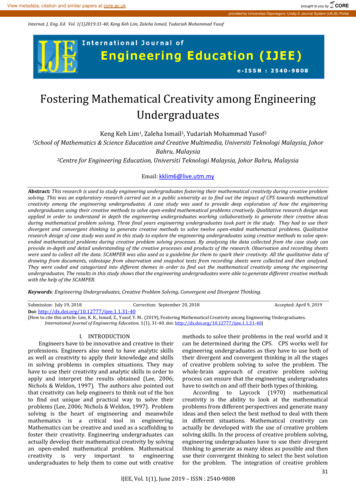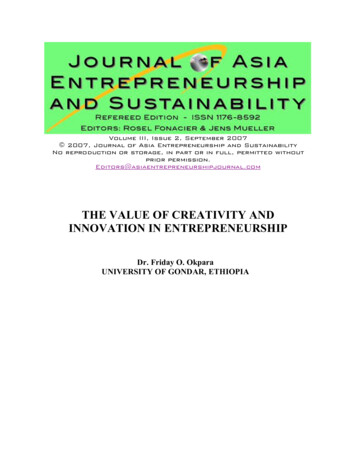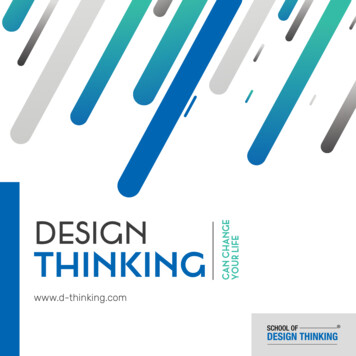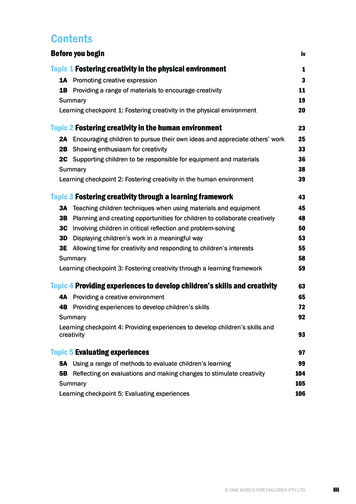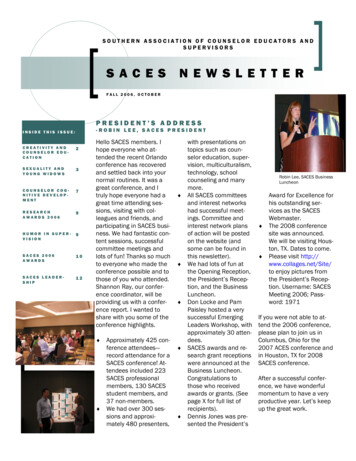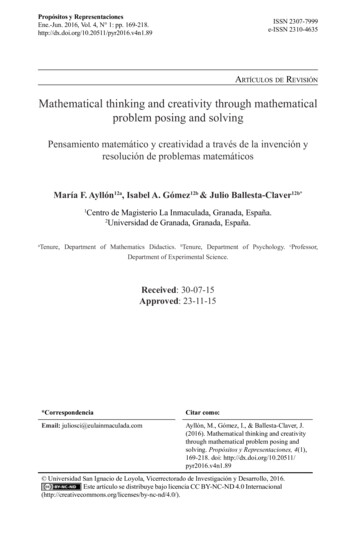
Transcription
Propósitos y RepresentacionesEne.-Jun. 2016, Vol. 4, N 1: pp. ISSN 2307-7999e-ISSN 2310-4635Artículos de RevisiónMathematical thinking and creativity through mathematicalproblem posing and solvingPensamiento matemático y creatividad a través de la invención yresolución de problemas matemáticosMaría F. Ayllón12a, Isabel A. Gómez12b & Julio Ballesta-Claver12b*Centro de Magisterio La Inmaculada, Granada, España.2Universidad de Granada, Granada, España.1Tenure, Department of Mathematics Didactics. bTenure, Department of Psychology. cProfessor,Department of Experimental Science.aReceived: 30-07-15Approved: 23-11-15*CorrespondenciaCitar como:Email: juliosci@eulainmaculada.comAyllón, M., Gómez, I., & Ballesta-Claver, J.(2016). Mathematical thinking and creativitythrough mathematical problem posing andsolving. Propósitos y Representaciones, 4(1),169-218. doi: http://dx.doi.org/10.20511/pyr2016.v4n1.89 Universidad San Ignacio de Loyola, Vicerrectorado de Investigación y Desarrollo, 2016.Este artículo se distribuye bajo licencia CC BY-NC-ND 4.0 by-nc-nd/4.0/).
Mathematical thinking and creativity through mathematical problem posing and solvingSummaryThis work shows the relationship between the development of mathematicalthinking and creativity with mathematical problem posing and solving.Creativity and mathematics are disciplines that do not usually appeartogether. Both concepts constitute complex processes sharing elements, suchas fluency (number of ideas), flexibility (range of ideas), novelty (uniqueidea) and elaboration (idea development). These factors contribute, amongothers, to the fact that schoolchildren are competent in mathematics. Theproblem solving and posing are a very powerful evaluation tool that showsthe mathematical reasoning and creative level of a person. Creativity ispart of the mathematics education and is a necessary ingredient to performmathematical assignments. This contribution presents some importantresearch works about problem posing and solving related to the developmentof mathematical knowledge and creativity. To that end, it is based on variousbeliefs reflected in the literature with respect to notions of creativity, problemsolving and posing.Keywords: Problem solving, problem posing, mathematics education andcreativity.ResumenEn este trabajo se muestra la relación entre el desarrollo del pensamientomatemático y la creatividad con la invención y resolución de problemasmatemáticos. No son frecuentes las ocasiones en las que aparecen juntasCreatividad y Matemáticas. Ambas constituyen procesos complejos quecomparten elementos como la fluidez (número de ideas), la flexibilidad(variedad de ideas), la novedad (idea única) y la elaboración (desarrollar unaidea). Estos factores contribuyen, entre otras cosas, a que los escolares seancompetentes en matemáticas. La invención y la resolución de problemasresultan ser un instrumento evaluador muy potente con el que se pone de196Propósitos y RepresentacionesEne.-Jun. 2016, Vol. 4, N 1: pp. 169-218.http://dx.doi.org/10.20511/pyr2016.v4n1.89
María F. Ayllón, Isabel A. Gómez & Julio Ballesta-Clavermanifiesto el nivel de razonamiento matemático y creativo de una persona.La creatividad forma parte de la educación matemática y constituye uningrediente necesario para realizar las tareas matemáticas. Esta aportaciónpresenta algunas investigaciones relevantes, que se han llevado a cabosobre invención y resolución de problemas, vinculadas al desarrollo delconocimiento matemático y a la creatividad. Para ello se parte de lasdistintas creencias que se recogen en la literatura referente a las nociones decreatividad, invención de problemas y resolución de problemas.Palabras clave: Resolución de problemas, invención de problemas,Educación Matemática y creatividad.Propósitos y RepresentacionesEne.-Jun. 2016, Vol. 4, N 1: pp. 197
Mathematical thinking and creativity through mathematical problem posing and solvingIntroductionThe main objective of teaching mathematics is to develop thinking. To thatend, it is necessary to carry out problem posing and solving assignments.When an individual has to pose a problem, they have to think, analyze theformulation critically, examine the data of such formulation and to handlesuch solving strategies that allow obtaining the solution to such problem.All of this is also practiced by solving problems. The solving and posing ofproblems help to strengthen what is learning. Therefore, Noda (2000) saysthat both activities are important for the mathematical knowledge building,which is an essential basic cognitive action for the education theory andpractice. For that reason, the concept of number and the problem solving andposing are considered the backbone of the school mathematical knowledge(Ayllón, 2012).Problem solving is a basic component for learning, as well as forknowledge acquisition. García (1998) considers that problem posing is apriority to consolidate and improve knowledge. He also advises that theresearchers can reach achievements through their scientific theories whenformulating, discovering or facing new problematic fields.When a person has to solve a problem, a priori, they think it is nota very easy assignment, which is a challenge to develop their creativity andmathematical skills.This circumstance also occurs in the problem posing. Problemposing allows getting meaningful learning and investigates the mathematicalskills of the person, when establishing relationships among the differentmathematical concepts, as well as numerical structures. To pose problems,it is necessary to have a high abstraction level and it demands reflection,which allows reaching a reasoning phase that facilitates the mathematicalknowledge building. The person that poses a math problem is based on198Propósitos y RepresentacionesEne.-Jun. 2016, Vol. 4, N 1: pp. 169-218.http://dx.doi.org/10.20511/pyr2016.v4n1.89
María F. Ayllón, Isabel A. Gómez & Julio Ballesta-Clavertheir own ideas, following a creative process. Therefore, a problem posingconstitutes the individual s own posing and not a reformulation of a problemalready posed.Since birth, people look for explanations for everything aroundthem, putting their creativity to work. Such creativity must be developed,stimulated and encouraged. For this reason, it is necessary to educate it andinclude it in schools. Barbarán and Huguet (2013) consider that a currenteducation system does not encourage creativity. They also say that it hindersit in some cases.Several researchers relate the problem posing to mathematical knowledge andcreativity development. Authors like Krutetskii (1969) and Ellertoh (1986)indicate the existence of an implicit relationship among the ability requiredto pose a problem and the creativity level, as well as the mathematicalcompetence. There is also an evident relationship between creativity andproblem solving (Callejo, 2003) since when every person has to solve aproblem, the creativity is activated when making that assignment. Ayllónand Gómez (2014) say that problem posing assignments develop creativityin schoolchildren and improve the acquisition of mathematical concepts.Problem Solving.Throughout the scientific literature, different studies address the problemposing field and they indicate that it is an important task to acquire mathematicalknowledge (Stoyanova & Ellerton, 1996; Nicolaou & Pilippou 2007; DeHaan,2009; Kesan, Kaya & Guvercin, 2010; Ayllón, 2012; Fernández & Barbarán,2012; Pintér, 2012; Espinoza & Segovia, 2013; Fernández, 2013; Ayllón &Goméz, 2014). It is true that research works on problem posing are not verycommon and not older than the research works on problem solving. However,since the last decades, this field has been increasingly addressed by authors.Propósitos y RepresentacionesEne.-Jun. 2016, Vol. 4, N 1: pp. 199
Mathematical thinking and creativity through mathematical problem posing and solvingResearchers refer to the term problem posing in several ways,such as problems (Kilpatrick, 1987), problem posing (Brown & Walter,1993), formulation and generation of problems (Silver, 1994). These termsallow the formulation of new problems or the reformulation of particularsituations (Silver & Cai, 1996). That is, a problem can be posed during itssolving (Silver, Mamona-Down, Leung & Kenny, 1996) through changesin it, reformulating and/or focusing on a particular case in order to betterunderstand the problem, and thus, solve it. A problem can be also posed onceit has been solved, modifying objectives, conditions and/or questions aboutit (Silver, 1994). Therefore, Brown and Walter (1993) explain how to posea new problem from a given problem following the strategy “What if not?”,which consists in modifying the conditions of a given problem.Shukkwan (1993) proposes a problem formulation from a givensolution, and Mamona-Downs (1993), views problem posing as the activitywhich is precipitated when the problem invites the generation of otherproblems.Espinoza, Lupiañez and Segovia (2013) consider several ways toformulate math problems: free situation, semi-structured situations andstructured situations (Stoyanova, 1998). Free situation does not require anycondition to pose a problem; semi-structured situation requires a specificstarting situation, and the structured situation refers to situation in which acondition of a given problem is modified.Problem posing requires to make a personal, own and creativecontribution, as well as to use mathematical knowledge already acquired andto relate several concepts. The problem posing is based on specific situationsand personal interpretations (Koichu & Kontorovich, 2012).In 2005, Christou, Mousoulides, Pittalis and Pitta-Pantazi carriedout a study that showed that the problem posing stimulates mathematical200Propósitos y RepresentacionesEne.-Jun. 2016, Vol. 4, N 1: pp. 169-218.http://dx.doi.org/10.20511/pyr2016.v4n1.89
María F. Ayllón, Isabel A. Gómez & Julio Ballesta-Claverlearning. It shows that when a person poses a mathematical problem, theyare obliged to establish relationships among several mathematical concepts,which involves several cognitive processes, like edit, select, understand,organize and translate the information from a representation form to another.Barbarán and Huguet (2013) carried out a study with first-gradesecondary students, in which it was evidenced that mathematical problemposing and reconstruction assignments encourage the creativity development.They say that they actively stimulate the creativity of students since theyoblige them to project their ideas generating original problems. They also saythat the problem posing allows the teachers to use a methodology in whichthe main character of their own learning is the student, thus encouraging thedevelopment of their creativity.Ayllón and Gómez (2014) consider the benefits of the problemposing, making a collection of the contributions of several researchers andcategorizing such aspects in 6 positive factors:1. Increase of mathematical and linguistic knowledge. Posing aproblem requires a clear writing of the formulation, in an organizedand accurate way. It requires data analysis and critical reasoning,discussion and questioning of ideas and solutions. Therefore, thecreator must write in a clear, accurate and organized way (Davidson& Pearce, 1988; Burçin, 2005; Whitin, 2006).2. Motivation increase. Problem posing stimulates the curiosity andmotivation of students (Silver, 1994; Akay & Boz, 2010).3. The decrease of anxiety that some students suffer in someopportunities causes their relationship with mathematics. Authorslike Burçin (2005) and Song, Yim, Shin and Lee (2007) say that,when a student makes problem posing assignments, their fear ofmathematics decreases.Propósitos y RepresentacionesEne.-Jun. 2016, Vol. 4, N 1: pp. 201
Mathematical thinking and creativity through mathematical problem posing and solving4. Overcoming mathematical mistakes often made by students. Brownand Walter (1993) say that the problem posing reduces resolvingerrors and mistakes made by students since they choose theinformation and the data in an appropriate way to solve the problem.5. Creativity increase. Authors like Krutetskii (1969), Ellertoh (1986)and Silver (1994) evidence the relationship among the skill to poseproblems and the creativity level and mathematical competence.6. As an evaluation tool. Problem posing is an evaluation tool forteachers. Teachers can better know the concepts learnt and theirstudents by means of this tool (Lin, 2004; Ayllón, 2005; Sheikhzade,2008). They can also value their type of mathematical reasoning.Problem Solving.Scientific literature is the problem posing with different meanings.Researchers identify the problem solving with different considerations.Koestler (1964) relates the problem solving to creativity. He says that whena person solves a problem, it is supposed to be a contribution to the creativityspark. Agre (1982) considers that the problem solving corresponds to aprocess in which knowledge learnt through a new but not familiar situation isused. Puig (1993) says that the problem solving is a mental activity producedfrom the moment the problem is proposed to the solver, who is consciousthat he has a problem and feels the need to solve it and finishes the activityonce it is solved. Contreras (1998) states that problem solving correspondsto a situation where a person who is facing a problem, they are capable tounderstand it, since they have knowledge previously learnt, but they do notknow how to solve it in that moment, although they try to find a solutionby facing such situation. Contreras also states that the problem solvingcorresponds to a task merely perceptive and conceptual.García (1998) considers 5 lines of research in the problem solvingfield: problem solving as a strategy to generate conceptual, methodological202Propósitos y RepresentacionesEne.-Jun. 2016, Vol. 4, N 1: pp. 169-218.http://dx.doi.org/10.20511/pyr2016.v4n1.89
María F. Ayllón, Isabel A. Gómez & Julio Ballesta-Claverand attitudinal changes; cognitive organization of knowledge and the problemsolving capability; comparison between expert individuals and beginners;design of heuristics for problem solving, and the creativity as a problemsolving. The last line indicates that the problem solving involves processeswhere it is necessary to modify a situation by generating creative ideas. Forthat reason, it considers that creativity is a way to solve problems and viceversa, that is, problem solving is an efficient way to develop creativity.Schroeder and Lester (1989) differentiate the problem solving workin the classroom in three categories to teach about problem solving, to solveproblems or via problem solving. They consider that teaching problem solvingis about working solving strategies, that is, the objective is that the studentknow how to solve problems. Teaching to solve problems means how to usethe mathematical knowledge already acquired in the problem solving. Thelast category, teaching via problem solving, consists in building on problemsto learn new mathematical problems. These threes objectives are different:the aim of the first one is that the students know how to solve problems; theaim of the second one is that the students strengthen their knowledge, and theaim of the third one is to use a problem solving methodology.One of the ideal frameworks for the meaningful learning constructionis problem solving, since it contributes to increasing the liking for mathematicsand encourages the development of a critical and open attitude (Carrillo,1996). As mentioned above, a person that faces a problem is learning andusing mathematical concepts already learnt.Authors, such as Polya (1965) states that problem solving is abarometer of mathematical knowledge. Along with this author, Gagné (1965)and Brown (1978) state that problem solving does not only use knowledgelearnt, but generates new knowledge.Propósitos y RepresentacionesEne.-Jun. 2016, Vol. 4, N 1: pp. 203
Mathematical thinking and creativity through mathematical problem posing and solvingHowever, to know how to solve problems, people must previouslylearn it. Brown (1978) states that problem solving, as well as the simplememorization, algorithmic learning and conceptual learning are a way oflearning. He states that the problem solving is a tool for construction andlearning indicated.Creativity.The development of a country depends on its scientific development. To thatend, it is necessary creative people. Ramos (2006, p. 9) states that “educatingto be creative is an essential requirement at the beginning of the 21st Century”.The Royal Spanish Academy (22nd Ed.) defines creativity as “theright to create, creation capacity”. Throughout the literature there is noagreement on creativity. Stein (1956) refers to creativity as a process whichresults in a useful novel work; De Bono (1974) states that creativity is amental attitude and a thinking instrument. Therefore, it is a way to use themind and information. De la Torre (1984) opines that creativity is an ability,while Goleman, Kaufman and Ray (1992) say that creativity is an attitude.However, Sorin (1992) says that every person can be creative, provided thatthey are unique in their field and produce innovations.Other definitions relate creativity to a thinking style. There arethose based creative processes, while others are based on creative products.Nadjafikhah and Yaftian (2013) state that creative thinking is a dynamicmental process that includes divergent and convergent thinking. Thedivergent thinking comprises 4 necessary elements to consider creative aproduction: fluency (number of ideas), flexibility (variety of ideas), novelty(unique idea) and elaboration (develop an idea).Therefore, creativity can be understand and defined in differentways, although it can be summed up as a personal or group activity aimed204Propósitos y RepresentacionesEne.-Jun. 2016, Vol. 4, N 1: pp. 169-218.http://dx.doi.org/10.20511/pyr2016.v4n1.89
María F. Ayllón, Isabel A. Gómez & Julio Ballesta-Claverat producing something new. Nevertheless, the definition of the NationalAdvisory Committee on Creative and Cultural Education (NACCCE, 1999,p. 30) is more recognized and it states that creativity is “any imaginativecreativity aimed at producing original and highly valuable results”. Bolden,Harries and Newton (2010) state that this reference of “originality” and“value” has an implicit social aspect, since ultimately society validates theproduct.García (1998) explains that creativity is characterized by thefollowing elements or capacities:a. Sensitivity to problems: This capacity allows the person to complicatesituations and find solutions.b. Flexibility: This capacity provides the possibility to change theapproaches of a problem, making people seek different strategies tosolve it.c. Thinking fluency: It allows generating ideas at any given time.d. Originality: Based on knowledge learnt, new knowledge aregenerated.e. Capacity to perceive non-obvious connections among facts; notpreviously established relationships among different experiences arediscovered.f. Representation capacity: new models are established and differentrelationships among their elements are discovered.Creativity and Mathematics Education.As a tradition, creativity was only attributed to the world of art and literature.Nowadays, it is related to the scientific world. To be creative, a scientific ideamust be new and useful. Mathematical thinking encourages the developmentof creativity since it requires to make conjectures and distinguish opinions tosolve a situation set out.Propósitos y RepresentacionesEne.-Jun. 2016, Vol. 4, N 1: pp. 205
Mathematical thinking and creativity through mathematical problem posing and solvingIn mathematics education, creativity is based on knowledge. Itconsists in building something new, previously getting rid of the ways ofthinking established, considering new possibilities and applying a widerange of mathematical knowledge (Bolden, Harries & Newton, 2010). Thejustification to carry out it is the cognitive flexibility, one of the three mainmental functions involved in the creative problem solving (Ausubel, 1963,2000). On the other hand, DeHaan (2009, 2011) says that it is possible toapply ideas to new contexts, to which he refers as “transfer” of knowledgecapacity. This allows the active development of the representations ofstudents and the conversion of the information received into something moreuseful, practical and constructive.Two ways of research referred to creativity and mathematicseducation are considered. They use the word creativity as a subject: creativityin mathematics education, or as an adjective: recreational mathematicseducation (Sequera, 2007). Research works on creativity in mathematicseducation consider creativity as a methodological element that helps toacquire the mathematical learning and makes sure that when applying theproblem solving, not only reasoning skills are developed, but also creativeones. In this discussion, creativity prevails, from which mathematics islearnt. The studies referring to the creative mathematics education statethat based on mathematics learning, creativity arises. Therefore, during aproblem solving process, a creative process arises.Problem Creativity and Posing.There are different methods to find out when a person is creative in researchworks. One of them is used by Getzels and Jackson (1962), in which problemposing tasks are carried out to measure creativity. The same technique wasused by Balka in 1974. He studied the productions of students based on theoriginality of formulations posed.206Propósitos y RepresentacionesEne.-Jun. 2016, Vol. 4, N 1: pp. 169-218.http://dx.doi.org/10.20511/pyr2016.v4n1.89
María F. Ayllón, Isabel A. Gómez & Julio Ballesta-ClaverSilver (1997) says that when teaching mathematics based on problemposing tasks, the teacher helps the students to develop their creativityincreasing their capacity of fluency, flexibility and novelty. Contributionsfrom other authors are considered like Van den Brink (1987), Streefland(1987), Healy (1993) and Skinner (1991), who state that problem posingencourages the development of fluency, being this the main characteristic ofcreativity.Singer, Perczer and Voica (2011) analyzed the creativity of 11 to 13aged students who pose problems. Their research work evidence that thosestudents who pose coherent and original problems through changes made intheir formulations have creative skills.Van Harpen and Sriraman (2013) carried out a study in China andThe United States of America with secondary students to analyze theircreativity. To that end, they performed activities based on problem posingwith geometrical concepts. The results showed that when a student poses amathematical problem, they develop fluency skills and it also showed thatstudents formulate problems with high quality elaboration and originality.These authors propose to include problem posing in the school curriculum,in the mathematics course due to its benefits for the students.Dickman (2014) carried out a study in which he investigated theexisting connection between the problem posing and creativity. To that end,he asked a group of primary teachers, psychologists who work in mathematicseducation and mathematicians to evaluate the problems posed to know howcreative they are. This study showed that there is no an agreement betweenthem since they do not share the same definition of creativity, although arelationship between creativity and problem posing is admitted.Propósitos y RepresentacionesEne.-Jun. 2016, Vol. 4, N 1: pp. 207
Mathematical thinking and creativity through mathematical problem posing and solvingCreativity and Problem Solving as Processes.Muñoz, in 1994, referred to the research works performed until that timeabout creativity, in aspects like the person, the process, the product and theenvironment.Creativity as a process refers to the necessary phases wherebyindividuals go through to achieve a creative product. In 1908, Poincaré definedthese phases and called them preparation, incubation and illumination. Thefirst phase corresponds to the initial time of conscious and intense work; thesecond phase refers to a break time, and the third one corresponds to the timein which ideas arises from the subconscious. In 1992, Goleman, Kaufmanand Ray considered these stages and added one more called “translation”.It is about the time in which the idea stops being a thought and it turns intoreality. Later, in 1998, García recalled and completed these stages in: a)encounter with the problem, stage in which the subject uses their criticalthinking, they feel the need to pose, solve the problem or even, to revealideas that they are worried about; b) generation of ideas, stage in which theperson seeks possible solutions based on inspiration and, thus, generates anew idea; c) idea development, when the creation or project is materialized,and d) creative transfer, which is the last stage of the posing process andwhere the new idea is related to other ones already known.These creative process stages correspond to the ones specified byHadamard (1945) and Polya (1965) with respect to the problem solvingprocess. Hadamard defines them in four stages: a) conscious work offamiliarization with the problem, b) semiconscious or unconscious workof ideas incubation, c) inspiration and illumination on the way to solveproblems, and d) verification that the inspiration really leads to the solution.On the other hand, Polya defines them in: a) problem understanding, b) planconception, stage in which a solving strategy is prepared, c) plan execution,and d) verification.208Propósitos y RepresentacionesEne.-Jun. 2016, Vol. 4, N 1: pp. 169-218.http://dx.doi.org/10.20511/pyr2016.v4n1.89
María F. Ayllón, Isabel A. Gómez & Julio Ballesta-ClaverThe necessary stages to develop a creative product coincide with thestages required to solve a problem. There is a relationship between preparationor encounter with the problem (creativity) and problem understanding andfamiliarization with it, since the two stages refer to the preliminary momentto be faced. The second and third stages, incubation and illumination orgeneration and elaboration of ideas, are found in the creative process and inthe problem solving, even in the identical names. The last stage, translationor creative transfer (creativity) and verification (problems), corresponds tothe time in which the objective set has been achieved.ConclusionsNowadays, the priority mission of teachers is to identify and developcreativity, and they need adequate environments for creative learning. Suchlearning requires to be flexible, to associate materials and ideas, have indirect,fostering and imaginative methodologies and to favor the relationshipbetween student and teacher (De la Torre, 1995). One of the greatestconcerns of teachers is to achieve that the teaching-learning of mathematicsdevelops logical thinking in students by means of constructivist and ludicmethodologies, to make mathematics a tool to be applied to daily life. Thislearning, thanks to the mathematical knowledge acquired, is connected to thestudent s creativity and its development.In view of the foregoing, it is evident that there is a relationshipbetween creativity and mathematics education. Such relationship worksboth ways. Mathematics is an instrument that allows solving problematicsituations arising in our daily life. This tool is based on the creation of newconcepts, solving strategies and/or different ways of thinking. Creativity is aninstrument of a mathematical activity. Vianney and Navarro (2011) state thatcreativity requires to build relationships among several concepts in order tocreate something new. To develop a mathematical thinking in an appropriatemanner, the problem posing and solving become important tasks, being thePropósitos y RepresentacionesEne.-Jun. 2016, Vol. 4, N 1: pp. 209
Mathematical thinking and creativity through mathematical problem posing and solvingbackbone of it, in which people have to relate ideas, associate concepts,use the memory and use the critical thinking. Therefore, it starts from theinnovation and creativity in problem posing and solving tasks.Creativity is part of the mathematical activity (Sequera, 2007), so itis implicit in the problem posing and solving activities, which identify themathematical abilities of students, turning them into a powerful evaluationinstrument for teachers.Whitin (2006) and Sequera (2007) encourages that problem posingtasks are included in the classroom in order to provide the students witha creative mathematics education, that is, a live and rich mathematicallearning in which the problems posed and their solutions are questioned,problem solving strategies encouraging imagination are forested and aflexible thinking is developed. Ayllón (2005) states that when an individualposes a problem, they internalize it, creating real and close contexts to them,increasing their desires to learn, daring to make mistakes and learning fromthem, and reducing fear felt at some point by some students when learningmathematics. The student must use their creativity to pose a mathematicalproblem.Currently, teaching mathematics, in several opportunities, stops thedevelopment of creativity when establishing a very strict action guides inproblem solving. It is necessary to foster creativity of students to
problem solving (Callejo, 2003) since when every person has to solve a problem, the creativity is activated when making that assignment. Ayllón and Gómez (2014) say that problem posing assignments develop creativity in schoolchildren and improve the acquisition of mathematical concepts. Problem Solving.
